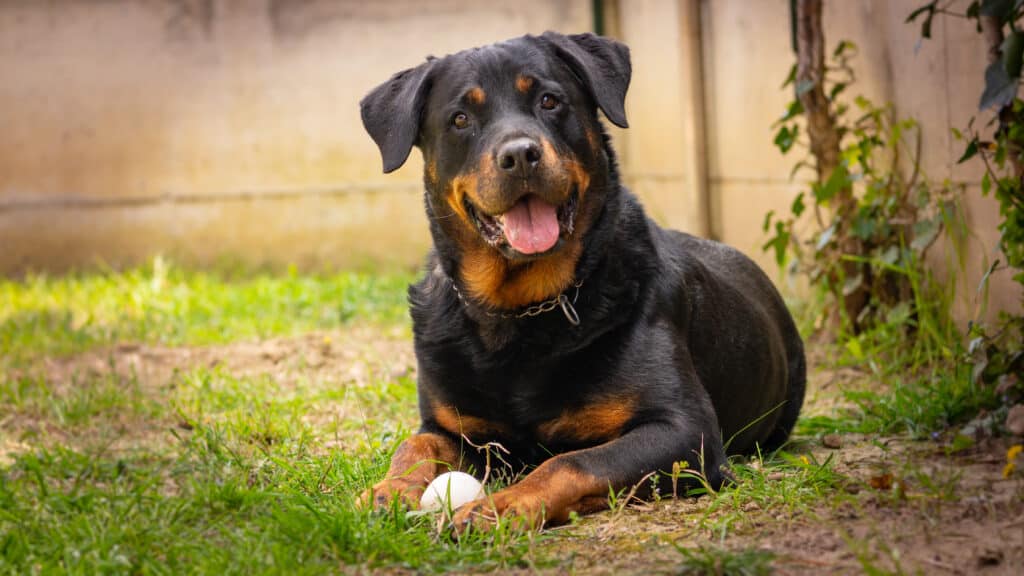Rottweilers make wonderful guard dogs and sweet, loyal companions. They’re active, loving, and beautiful! But before adopting one, many people want to know if Rottweilers shed.
Rottweilers shed moderately most of the year, and more profusely during shedding season in spring and fall. They have double coats on their neck and thighs that blow out as the seasons change. Rotties aren’t high-maintenance and require only a weekly brushing to keep their coat healthy.
Unfortunately, Rottweilers aren’t hypoallergenic or low-shedding. However, they’re also not excessive shedders, though you will find fur around your home year-long. Because a Rottie’s coat is black, it’ll be pretty noticeable around the house and on your clothes.
Keep reading to learn more about the Rottweiler coats, how much they shed, and how to manage their shedding.
Rottweiler Coat Characteristics
| Coat Length | Short |
| Shedding Level | Moderate |
| Grooming Needs | Brush coat once weekly |
| Fur or Hair? | Fur |
| Hypoallergenic? | No |
How Long Do Rottweilers Shed For?

Rottweilers shed year-round.
©nicolas.fontana/Shutterstock.com
Rottweilers shed year-round, but they tend to have heavier shedding seasons in the spring and autumn months. During this time, the dogs blow out their undercoats. You’ll especially see this increased shed around their neck and on their thighs.
During shedding season, your Rottie will need to be brushed more frequently to keep its coat free of loose fur and to control its shedding.
Frequent brushing also distributes your pup’s natural oils along its coat and skin, making it healthier, shiny, and sleek.
Do Rottweilers Smell?
Rottweilers can smell, but not more than any other dog. All dogs have a distinct odor, which you might notice most when they’re wet or have just come in from outside.
If your Rottie smells beyond this, it might need a scrub-down with some dog shampoo. You can also use dry shampoo in-between baths if your Rottie is particularly messy, as this will help prevent you from drying out its skin with excessive bathing.
Smelly dogs can also get their odor from various health conditions, including skin infections, ear infections, and dental problems. If your pup’s odor doesn’t clear up after a good bath, see your veterinarian to rule these out.
How Can I Stop My Rottweiler From Shedding?

You can reduce the shedding from your Rottweiler, but you can’t stop it entirely.
©otsphoto/Shutterstock.com
Unfortunately, there’s no way to stop your Rottweiler from shedding. However, you can reduce its shedding in several ways:
- Brush your Rottweiler more frequently, at least once a week.
- Use a deshedding brush to rake out your dog’s undercoat.
- Bathe your pup with some deshedding shampoo.
- Feed your dog a high-quality diet to keep its coat healthy.
Here are some tips to keep your house free of Rottweiler fur:
- Vacuum or sweep regularly—pet attachments are a must-have for the furniture and stairs!
- Use a carpet rake to get more stubborn hairs out of your carpeting or rugs.
- Brush your Rottweiler outside to keep fur from flying around your home.
- Purchase a reusable lint roller so that you don’t have to keep buying disposable ones. This is also better for the environment.
How to Groom a Rottweiler
There are several steps to grooming your Rottie. Below, we’ll walk through the following so that you know how to groom your pup from start to finish:
- Brush your Rottweiler once a week.
- Bathe it every few months with a dog-friendly shampoo.
- Brush its teeth as frequently as possible.
- Trim its nails weekly.
- Clean the ears at least once a month.
Brushing Your Rottweiler

Brush your Rottweiler once weekly with a short slicker brush or any other brush made for short-haired dogs.
©iStock.com/Ideas_Studio
Brush your Rottweiler once weekly with a short slicker brush or any other brush made for short-haired dogs. During shedding season, I recommend switching to an undercoat rake, which will help to remove your Rottie’s undercoat.
Ramping up your grooming during the shedding season in the spring and fall is a good idea. Brush your Rottie every few days to remove stuck undercoat and to keep its coat healthy and sleek.
Pay special attention to the fur around your Rottie’s neck and thighs, especially during shedding season. This is where most of its undercoat is located, so these areas will shed more.
While brushing your pup, separate the coat down to the skin to look for any redness, sores, or pests. Also note whether its hair feels dry, greasy, or has any bald patches. Performing these quick health checks during grooming can help you catch illness early and get your Rottie seen by the vet!
Bathing Your Rottweiler
Use a dog shampoo to bathe your Rottweiler every few months, or as needed. You’ll know it’s time if it stinks, the coat feels oily, or it has just done something messy, such as splashed through rain puddles.
People have different preferences when it comes to dog shampoos. I personally love oatmeal-based shampoos, but you might prefer to use a deshedding shampoo during the shedding season to help with its constant shedding!
If your Rottie suffers from dry skin, consider dandruff shampoo. You can follow it up with a dog conditioner or coconut oil for extra moisturizing.
When your Rottweiler needs a touch-up between baths, dry shampoo also comes in handy!
While scrubbing your dog’s body, feel for any abnormal lumps or bumps on the skin. See a veterinarian if you notice anything unusual.
Brushing Your Rottweiler’s Teeth

Brush your Rottweiler’s teeth at least once weekly.
©Tatiana Makotra/Shutterstock.com
If your Rottweiler allows, brush its teeth at least once weekly. Daily is even better! This can help prevent cavities, tooth decay, and other dental problems. Ideally, you should start brushing your dog’s teeth as young as possible, so it is used to the feeling.
Of course, this isn’t always possible if your dog is a rescue, and training adult dogs can be more difficult, though not impossible.
Here’s how to brush your Rottweiler’s teeth:
- Choose a safe dog toothpaste: Never use human toothpaste, as this can harm your dog when swallowed.
- Decide which type of toothbrush to use: Some go on your finger, making it easier to get into your dog’s mouth (so long as it won’t bite down). Others are longer and shaped more like human toothbrushes.
- Get your Rottie used to the toothbrush: Allow it to sniff it and lick small amounts of toothpaste off of it. Once it gets used to having it around, slowly work up to putting it in its mouth, then brush a few teeth at a time. This can be a slow process, so hang in there!
- Gently open its mouth and brush its teeth: Wiggling around, trying to lick the toothpaste, and backing away are all normal at first. It’ll take training, and maybe some yummy treats, before your pup learns.
- Reward your Rottweiler for good behavior: Give it treats and lots of praise.
Alternatives to teeth brushing if your Rottie isn’t there yet, or if you prefer not to, are dental chews. These can be given in moderation to help your pup’s dental health.
You can also speak to your veterinarian about dental cleanings. These are usually recommended around once a year.
Trim Your Rottweiler’s Nails Weekly
Rottweilers’ nails grow fast, so the American Kennel Club recommends weekly nail trimming. This will prevent your pup’s nails from growing too long, which can cause them to dig into the paw pads, get stuck on objects, or break painfully.
Before trimming your Rottie’s nails, I recommend taking a look at some white dog nails. This will give you a better idea of how dog nails are structured since Rottweiler nails are dark.
Near the base of the nail, nearest to the paw, is the quick. This looks pink on a white nail but isn’t visible on dark nails like Rotties have. This makes it very easy to cut into.
The quick is full of blood and will bleed if you cut it. It can also be splintered if the nail trimmers you use are dull.
Here’s how to cut your Rottweiler’s nails successfully:
- Use a clean, sharp pair of nail trimmers: Make sure they’re made for large dogs.
- Train your Rottweiler to accept nail trimmings by handling its feet frequently and touching the trimmers to its paws without cutting.
Some dogs are afraid of the sound the trimmers make, so be sure to desensitize your dog to this as well by pinching them together away from the claw and giving your dog treats. - Once it’s ready, trim just the tip of your Rottie’s nails. It’s okay to only trim one or two at first, then come back to do more later.
- When in doubt, cut less, not more: You can always come back to get the nail shorter, but once you cut too long your pup will be in pain.
- If you cut into the quick, use flour or cornstarch to stop the bleeding: Rub it into the cut end of the nail. If the nail continues to bleed after a few minutes, see a veterinarian.
If you don’t feel comfortable trimming your Rottie’s nails, consider having a veterinarian or dog groomer do it for you.
Other options include using a nail dremel or teaching your Rottweiler to scratch a dog scratchpad. Both of these items are made to file your dog’s nails down slowly, making it much less likely to damage the quick.
Lastly, I recommend checking over your Rottweiler’s paws during nail trims. Look for broken nails, splinters, and cracked or dry paw pads. Coconut oil can help to moisturize the paw pads if you feel it needs it!
Cleaning Your Rottweiler’s Ears

Your Rottie’s ears should be cleaned at least once a month.
©McCann Michelle/Shutterstock.com
Your Rottie’s ears should be cleaned at least once a month, or as needed. Some Rottweilers may keep their ears clean enough that you don’t need to help, but usually, there will be some wax and debris on the outer ear.
Here’s how to clean your Rottweiler’s ears:
- Grab your supplies: You’ll need either an ear wash made for dogs or a small amount of baby oil. Put your ear cleaner of choice on a paper towel, cotton pad, or cotton ball.
- Turn the ear over so that it rests on top of your Rottweiler’s head.
- Gently wipe the outer ear: This means wiping the underside of your Rottweiler’s ear while avoiding the ear canal, or inner ear.
- If required, use q-tips to clean the folds: Never stick anything into your dog’s ear canal, though!
- If there is excess wax inside the ear canal, see a veterinarian for professional cleaning: Don’t attempt to do this yourself, as you can lodge the wax deeper or injure your dog’s ear drum.
Cleaning your dog’s ears will help to prevent ear infections, and to stop its ears from becoming itchy or uncomfortable from buildup.
During ear cleanings, I also recommend checking the ears for any redness, swelling, or abnormal discharge. These can indicate an ear infection or ear mites.
Up Next:
- 10 Incredible Rottweiler Facts
- Rottweiler Lifespan: How Long do Rottweilers Live?
- Serbian Rottweiler vs. German Rottweiler
The photo featured at the top of this post is © Olexandr Andreiko/Shutterstock.com
Ready to discover the top 10 cutest dog breeds in the entire world?
How about the fastest dogs, the largest dogs and those that are -- quite frankly -- just the kindest dogs on the planet? Each day, AZ Animals sends out lists just like this to our thousands of email subscribers. And the best part? It's FREE. Join today by entering your email below.
Sources
- American Kennel Club, Available here: https://www.akc.org/dog-breeds/rottweiler/
- VCA Animal Hospitals, Available here: https://vcahospitals.com/know-your-pet/ear-infections-in-dogs-otitis-externa
- VCA Animal Hospitals, Available here: https://vcahospitals.com/know-your-pet/dental-disease-in-dogs
- NexGard, Available here: https://nexgard.com.au/parasite/mites/does-my-dog-have-ear-mites#:~:text=Ear%20mites%20live%20in%20the,unpleasant%20odour%20from%20the%20ears.
- Guilford-Jamestown Veterinary Hospital (1970)
Thank you for reading! Have some feedback for us? Contact the AZ Animals editorial team.






